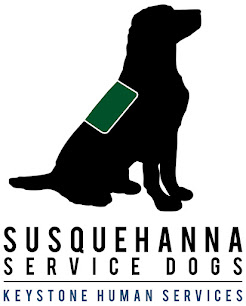 Service dogs play an important role in people's lives. They are so much more than just loving friends - they change the lives of their partners through their assistance. With the assistance of their service dog, individuals who may have had to depend on other people to help them are able to perform tasks for themselves. Service dogs provide support and independence and enrich lives.
Service dogs play an important role in people's lives. They are so much more than just loving friends - they change the lives of their partners through their assistance. With the assistance of their service dog, individuals who may have had to depend on other people to help them are able to perform tasks for themselves. Service dogs provide support and independence and enrich lives.Because they will play such an important role in individuals' lives, the dogs must meet certain criteria in order to become service dogs. We breed, raise and train Labrador retrievers to become service dogs. We use Labs because of their intelligence, agility and gentle, even temperament. Labs tend to be cheerfully obedient and genuinely enjoy cooperating with people. Also, Labs are known for having "soft" mouths, meaning they can pick things up with their mouth without puncturing or marking them in any way. This is especially important because service dogs may often be retrieving things for their partners.
All of our dogs begin training from the moment they are born. We begin interacting with the puppies to get them used to being around people. When the puppies are eight weeks old, they go to puppy raisers - volunteers who raise the puppies and train the
 m in some of the skills and manners they will need to be good service dogs. The puppies also attend puppy classes, and once they are 15-18 months old, they enter advanced training. We'll share more about puppy raisers in a future post. For now, if you'd like more information, please visit our puppy raiser page.
m in some of the skills and manners they will need to be good service dogs. The puppies also attend puppy classes, and once they are 15-18 months old, they enter advanced training. We'll share more about puppy raisers in a future post. For now, if you'd like more information, please visit our puppy raiser page.Not just any dog can become a service dog. In fact, some of the dogs we specially raise and train do not have the right characteristics to become service dogs. For example, SSD Honeycrip and SSD Penny were discharged from our service dog training. While both of these dogs had excellent manners, they had a tendency to intently follow their noses, making them too olfactory and intense for service dog work. However, their olfactory skills made them perfect candidates to be accelerant dogs, and they both now have careers with the New York State Troopers as accelerant dogs working at the United Nations. Other dogs that do not become service dogs may become therapy dogs or companion dogs or may even be adopted as pets. No matter what direction their "careers" take them, all of our dogs find loving homes.
However, in order to become service dogs, our dogs must meet certain criteria and display certain characteristics that tell us they will be able to fully serve their prospective partners. This new blog series will talk about the characteristics we look for in all of our service dogs and the training our dogs go through on their journey. We hope you learn a little more about what our service dogs do and maybe even find some training tips you can use with your own dogs.









Most of the service dogs that I have seen have been yellow labs. (I notice now, though, that the dog at the top of your blog is a black lab.)
ReplyDeleteIs there any reason why yellow labs seem to be used more often that black or chocolate?
cheers,
Mary H.
http://stalecheerios.com/blog
Hi Mary H. The color of service dogs really doesn't matter to us. We make our breeding decisions based on health and temperament, so it's usually a surprise to see what color the puppies are. Actually, though we only breed labs, we will train other breeds as service dogs. SSD Bella, who was donated to us, is a poodle!
ReplyDeleteI am training my own hearing dog. He is also a PSTD dog, as he made that special bond with me. He distracts people to him, so I can do my shopping or relax from panic attacks. Which I had every time I would food shop, etc. However, everytime I am in a store-or practicing-people distract him or I get harrassed because he is not a Lab or Golden Retriever. He has alerted me to door bells, etc. And I am perfecting the phone, music alarm clock etc. I was not aware that if a bell went off in a store-that it was ok for him to bark and point, at the time. I thought he should always be quiet. This was only because it took me awhile to find a book on hearing dog training. The book was usually expensive-I got it at a bargain. My dog has found my Mom collapsed-and went to her. I did not know at the time why he was going so crazy for me to let him go in her room. She is alive today because of him. He had two behavioral classes with a CGC teacher. He is invaluable to me. But store employees constantly approach and some are very harrassing, as I have a meeting with an owner whose employee demanded I leave the store-even after being told he is a SD. The hearing part, is still in training-but I do know the signs he conveys if there is a strange noise. A loudspeaker making an annoucement etc.
ReplyDeleteHe will sit up, or his ears go crazy. And I know to try and listen carefully. Especially, since my Mom, who is on oxygen often will wander in a store. She has paged me-but I didn't hear. His body movements helped. He tells me if a stranger approaches, and cars/people in parking lots. I am perfecting the down-stay. I make a game of it, with lots of praise and treats for leave it and stay. It is hard to train your own dog. But Boo learns fairly easily. But it is a major setback for both of us, if he gets distracted. He knows that if someone approaches,because he is so cute and they make him excited. So I have been working on that point. Training him "friend" has helped with that. Only because I get so nervous, he feels that through the leash. I thought it would be easier if he was used to these people approaching. He is a small dog, so he will compensate with woofs. He is stopped immediately. So he doesn't upset shoppers. And I have used a corrector-because all it does, is make a predatory sound. It is very humane. It would help if people understood that when they see a SD-even in training, not to approach with loud voices, and
hyper movements. Although, he has been doing great with that now. Only gets out of work mode, if they try and pet him. He knows if they come to close to me to distract them to him. I tell them he is a service dog, and tell him calm. Which he usually is-but they make him stay in carts at supermarkets. Stating his size, etc. So I have kept him calm both down and up. I hope this is helpful. Any suggestions are welcome. Gina